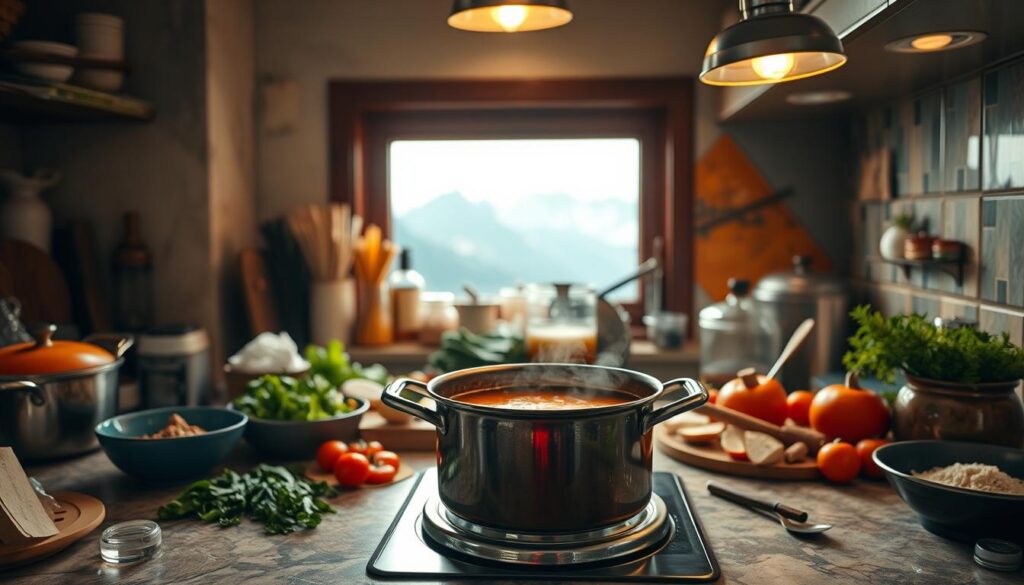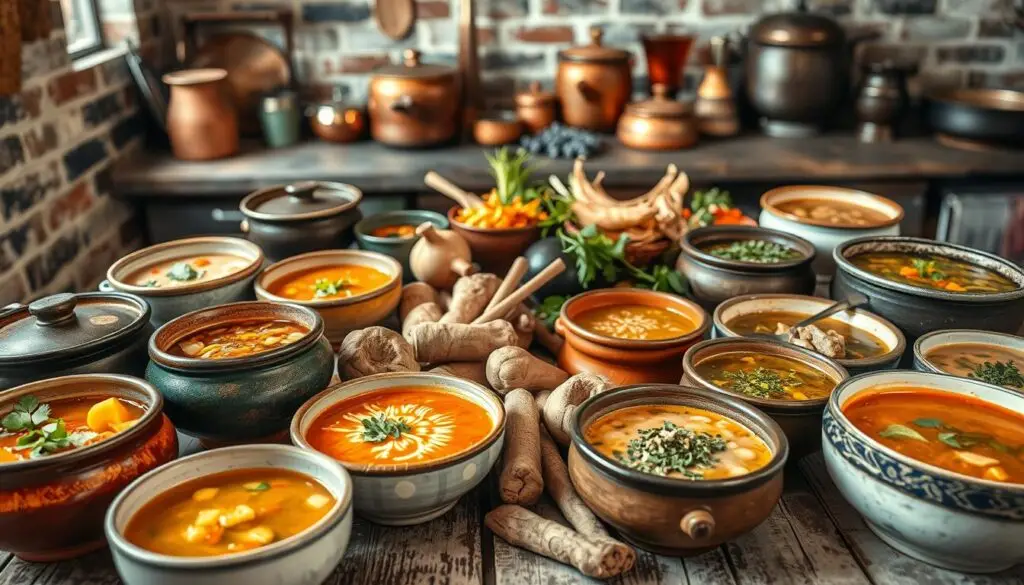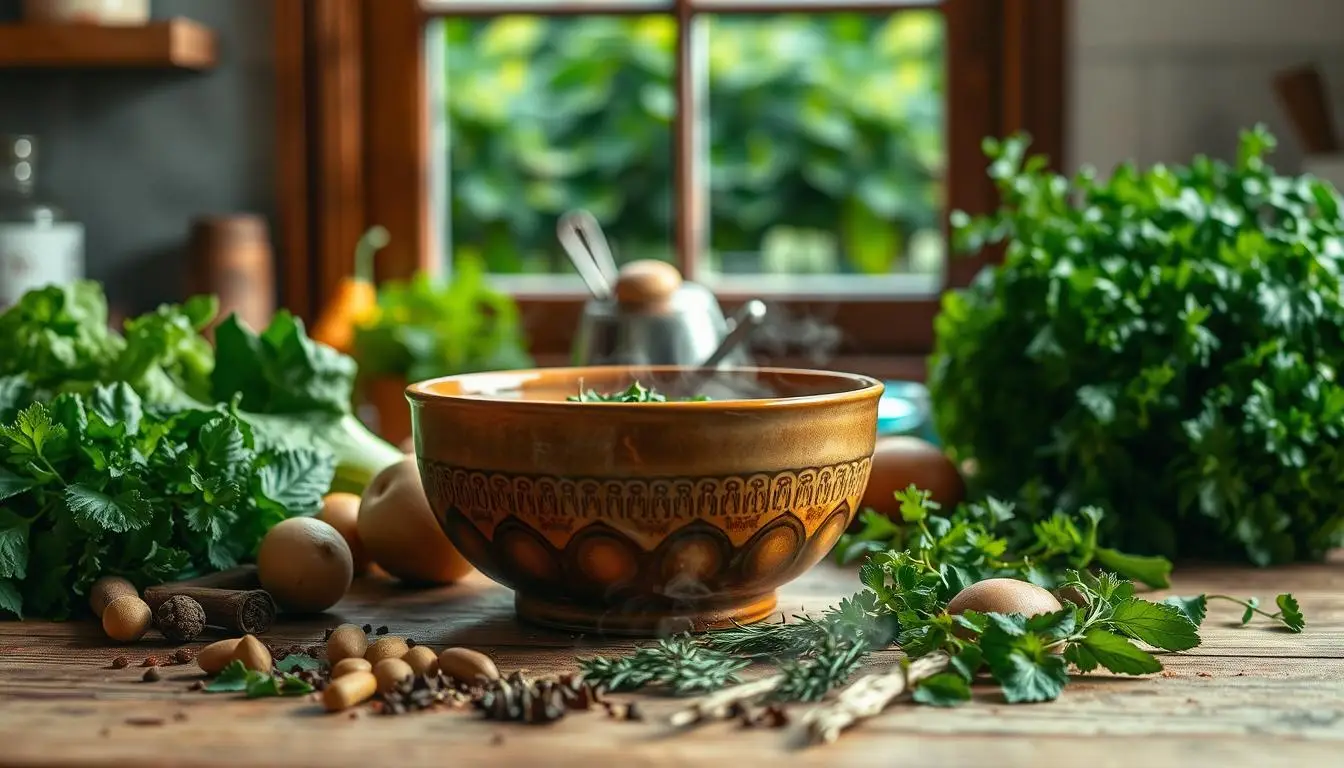Exploring Soup Recipes in Abiotic Factors: A How-To Guide
Table of Contents
Every great chef knows that making the perfect soup is more than just throwing ingredients together. It starts with understanding the complex dance of abiotic factors that affect every spoonful. These hidden ingredients turn an ordinary meal into a work of art, full of flavor and nutrition.
Remember that special soup your grandmother used to make? What made it so unforgettable? The secret was in the environmental elements that shaped each ingredient’s taste and texture. Easy soup recipes are not just about following a recipe. They’re about connecting with nature.
Abiotic factors are key to the quality of your ingredients. From the soil where veggies grow to the water used in cooking, these elements are the kitchen’s unsung heroes. Knowing about them can take your soup-making from good to amazing.
In this guide, we’ll explore the world of soup recipes and abiotic factors. We’ll see how environmental conditions affect your cooking. Get ready to change how you cook and learn the science behind making incredible soups.
Understanding Abiotic Factors in Culinary Arts
Making healthy soup recipes is more than just mixing ingredients. Abiotic factors in cooking are key to making your dishes stand out. These non-living elements affect the quality and taste of every ingredient you choose.
Exploring Non-Living Environmental Factors
Abiotic factors include various environmental conditions that impact ingredient quality. These important elements are:
- Temperature variations
- Humidity levels
- Water availability
- Soil composition
Impact on Ingredient Quality and Selection
Knowing these environmental factors is vital for your soup’s success. Different conditions change how ingredients taste and feel. For example, local soil minerals can make vegetables in your soup taste better.
| Abiotic Factor | Impact on Ingredients |
|---|---|
| Water Quality | Affects broth texture and taste |
| Temperature | Influences ingredient growth and nutrient density |
| Soil Composition | Determines vegetable mineral content |
Role in Recipe Development
Professional chefs know that abiotic factors are not just background noise. They’re essential. By understanding these environmental details, you can improve your soup-making skills. This leads to more complex and flavorful dishes.
*Environment shapes flavor, one ingredient at a time.*
More than 80% of the world eats soup every day. This shows that mastering these environmental interactions can change your cooking. It can make your meals unforgettable.
Essential Water Properties for Perfect Soup Making
When making delicious soups, knowing about water is key. Water isn’t just a liquid; it’s a vital ingredient. It changes your soup’s texture, flavor, and quality.
Water’s characteristics can surprise you in cooking. For vegetarian soups, the water’s quality is even more important. Small flavor changes can make a big difference.
“Water is the silent chef in your kitchen, defining the soul of every soup.” – Culinary Wisdom
Water Quality Factors
- Hard water can create a chalky mouthfeel
- Soft water might produce thin, less flavorful broths
- Mineral content affects taste intensity
Temperature is also key in making soup. Different soups need different temperatures:
| Temperature Range | Soup Type |
|---|---|
| 150°F – 180°F | Delicate, cream-based soups |
| 180°F – 200°F | Clear broths and light soups |
| 200°F – 220°F | Hearty stews and robust soups |
Tip for soup lovers: Use filtered or soft water for the best taste. Your taste buds will love it!
Water Safety Recommendations
- Store soups at 40°F or below
- Reheat soups to 165°F for food safety
- Filter water to remove unwanted minerals
Mastering water properties can make you a pro at soup-making. Start your journey to making amazing soups by learning about this essential ingredient.
Soil Composition and Its Effect on Ingredients
Knowing about soil composition is key to making tasty homemade soups. The soil under your ingredients greatly affects the flavor, nutrition, and quality of your dishes.
Mineral Content’s Flavor Impact
Soil minerals give veggies and herbs in soups their special taste and health benefits. Elements like calcium, magnesium, and potassium change how your ingredients taste and what they offer nutritionally.
- Calcium-rich soils make veggies sweeter
- Magnesium boosts chlorophyll in plants
- Potassium helps plants grow well
pH Levels and Plant Growth
Soil pH is important for how plants absorb nutrients. Most veggies grow best in slightly acidic to neutral soils (pH 6.0-7.0). This helps them absorb nutrients better and taste more flavorful in your soups.
| Soil pH Range | Vegetable Performance | Flavor |
|---|---|---|
| 5.5-6.5 | Optimal Growth | Rich, Complex Flavors |
| 6.5-7.5 | Good Growth | Balanced Taste |
| Below 5.5 or Above 7.5 | Reduced Nutrient Uptake | Diminished Flavor |
Local Soil Varieties in Cooking
Trying local soil varieties can make your soups special. Terroir – the environment where food is grown – greatly affects ingredient quality. Local farmers know a lot about the soil that makes your soups taste unique.
By learning about soil, you can turn simple soups into amazing dishes. These dishes will show off the special flavors of your local area.
Altitude Considerations in Soup Preparation

Preparing soup at different altitudes changes your cooking experience. Elevation affects how ingredients cook. Knowing these changes helps you make soups that taste and feel the same everywhere.
Altitude impacts several key cooking factors:
- Water boiling temperature
- Cooking time requirements
- Pressure changes
- Ingredient moisture retention
At higher elevations, water boils at lower temperatures. For every 500-foot increase, the boiling point drops about 1 degree Fahrenheit. This means your soups need longer cooking times at higher altitudes.
| Altitude Range | Boiling Point | Cooking Time Adjustment |
|---|---|---|
| Sea Level (0-2,000 ft) | 212°F | Standard Recipe Time |
| High Altitude (3,000-6,000 ft) | 202-204°F | Increase by 15-25% |
| Very High Altitude (7,000-10,000 ft) | 198-200°F | Increase by 25-40% |
When making soup at different altitudes, keep these tips in mind:
- Use a bit more liquid to make up for faster evaporation
- Slowly increase cooking times
- Watch how ingredients get tender
- Adjust seasonings to keep flavors strong
Understanding how altitude affects soup making lets you use adaptable cooking techniques. This way, you can make delicious soups no matter where you are.
Soup Recipes Abiotic Factors: Seasonal Adaptations
Seasonal changes greatly affect soup recipes, making each month a new experience. Knowing how to pick ingredients based on the season helps you make healthy soups that truly capture the essence of each time of year.
Your soup-making journey changes with the seasons, giving you chances to try new, local ingredients. Let’s look at how you can make delicious soups that show off the unique qualities of different seasons.
Spring and Summer Soup Collections
In warmer months, focus on light, refreshing soups that highlight fresh produce. Here are some vibrant options:
- Chilled gazpacho with ripe tomatoes
- Zucchini and herb-infused vegetable soup
- Cucumber and mint cooler soup
Fall and Winter Warming Recipes
When it gets colder, switch to hearty, warming soups that offer comfort and nutrition. Try these seasonal favorites:
- Butternut squash and apple soup
- Roasted root vegetable medley
- Hearty lentil and kale winter soup
Adjusting Ingredients by Season
Your soup-making should be flexible. Seasonal ingredient availability means changing recipes to use what’s freshest and most abundant. Local farmers markets are great for finding peak-season produce for amazing soups.
Regional Diversity in Traditional Soup Making

Exploring soup recipes from around the world shows a rich culinary scene. It’s deeply tied to the local environment. Traditional soups reflect the unique conditions of each place, turning simple ingredients into dishes full of culture.
In the Eastern Himalayas, the Limboo people have created amazing vegetarian soups. Their use of fermented soybeans shows how local ingredients shape their cooking. This highlights how the environment affects their recipes.
- Soybean cultivation adapted to specific local climates
- Fermentation processes tailored to regional temperature ranges
- Preservation techniques using local resources like wood ash
When thinking about soup recipes, consider the regional differences. Understanding how local conditions shape cooking traditions is key. Different environments give ingredients unique flavors.
Vegetarian soups really stand out when they use local ingredients. By choosing ingredients from nearby farms, you can make soups that truly represent a place. From Himalayan fermented soybean dishes to Mediterranean vegetable soups, each tells a story of its environment.
Every soup is a reflection of its environment – a delicious testament to local ecological conditions.
Sustainable Ingredient Sourcing Guidelines
Making healthy soup recipes is more than picking ingredients. It’s about connecting with local food systems that care for the environment.
Starting to source ingredients responsibly can change how you cook. By choosing local and seasonal, you make soups that are good for you and the planet.
Local Farming Partnerships
Working with local farmers has big benefits for your soups:
- It cuts down on emissions from transport
- It boosts local farms’ economies
- You get fresher, more nutritious food
- You learn about local cooking factors
Seasonal Availability Charts
Knowing when ingredients are in season makes your soups better. Here’s a guide to regional produce:
| Season | Recommended Vegetables | Nutrient Highlights |
|---|---|---|
| Spring | Asparagus, Peas, Spinach | High in Vitamin K, Folate |
| Summer | Tomatoes, Zucchini, Corn | Rich in Vitamin C, Antioxidants |
| Fall | Pumpkin, Squash, Kale | Excellent Beta-Carotene Sources |
| Winter | Root Vegetables, Cabbage | High in Fiber, Minerals |
Environmental Impact Considerations
When picking ingredients for your soups, think about these green tips:
- Go for organic when you can
- Plan to avoid food waste
- Choose low-carbon footprint ingredients
- Compost veggie scraps
By using green practices, you make tasty soups that are good for everyone and the planet.
Step-by-Step Recipe Development Process
Making tasty soup recipes for beginners needs a careful plan. It’s a mix of science and creativity in cooking.
Begin by learning the basics of soup making. Chefs say a clear method leads to great taste and consistency.
- Ingredient Selection
- Choose fresh, seasonal produce
- Consider local water properties
- Evaluate mineral content impacts
- Flavor Profile Development
- Balance base ingredients
- Layer complementary flavors
- Adjust seasoning progressively
- Environmental Adaptation
- Account for altitude variations
- Modify cooking times
- Adjust liquid ratios
Pro tip: Document each experimental batch with detailed notes on ingredients, cooking conditions, and flavor outcomes.
“Mastering soup recipes is about understanding the relationship between ingredients and environment.” – Culinary Expert
| Factor | Impact on Soup Recipe | Recommended Action |
|---|---|---|
| Water Quality | Affects overall taste | Use filtered water |
| Altitude | Changes cooking time | Adjust liquid and cooking duration |
| Seasonal Ingredients | Influences flavor complexity | Select peak-season produce |
With time, your soup making will get better. Each batch teaches you about ingredients and cooking.
Conclusion
Your journey through soup recipes shows us how the environment affects our cooking. Learning about water, soil, and seasons can make simple ingredients into amazing meals. Easy soup recipes become a way to show off your local environment.
The science of making soup is more than just ingredients. It’s about understanding minerals, water quality, and regional differences. This knowledge can make your cooking better. For example, vegetable broths have more calcium and iron than others.
Your kitchen is a place where environment and cooking meet. Using local and seasonal ingredients adds depth to your soups. This connection lets you create new and tasty dishes.
Keep trying new soup recipes and see your local environment as a resource. Use its unique features and choose sustainable ingredients. Your next great soup is just waiting for you to discover it.
For More Easy Soup Recipes Check this List





